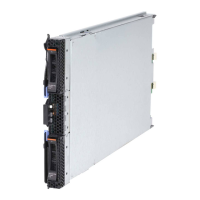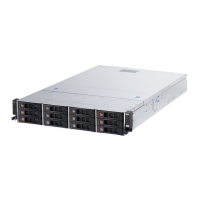4. Select the device driver that you want to configure and press Enter.
5. When you have finished changing settings, press Esc to exit from the program;
select Save to save the settings that you have changed.
Configuring the Gigabit Ethernet controller
Use this information to locate the device drivers for the Gigabit Ethernet controller.
One dual-port Gigabit Ethernet controller is integrated on the blade server system
board. The controller provides a 1000 Mbps full-duplex interface for connecting to
one of the Ethernet-compatible I/O modules in I/O-module bays 1 and 2, which
enables simultaneous transmission and reception of data on the Ethernet local area
network (LAN). The Ethernet controller on the system board is routed to
I/O-module bay 1 or bay 2. The logical link of each Ethernet port to an
I/O-module bay is assigned by the operating system.
You do not have to set any jumpers or configure the controller for the blade server
operating system. However, you must install a device driver to enable the blade
server operating system to address the Ethernet controller. For device drivers and
information about configuring the Ethernet controller, complete the following steps.
Note: Changes are made periodically to the IBM Web site. The actual procedure
might vary slightly from what is described in this document.
1. Go to http://www.ibm.com/support/.
2. Under Select product or service type for support, select BladeCenter.
3. Under Popular links, click Software and device drivers.
4. From the IBM BladeCenter menu, select BladeCenter HS22.
5. From the download categories, click the Networking category.
6. Find the device driver for your operating system; then, click on the version
number to go to the download page for the device driver.
Configuring a RAID array
Use this information to configure a RAID array.
Configuring a RAID array applies only to a blade server in which two or more
storage drives are installed.
Note: When configuring a RAID array, the storage drives must use the same type
of interface. For example, a RAID array can be configured with two SAS storage
drives, two SATA storage drives, or two SSD storage drives.
You can use two storage drives in the blade server to implement and manage
RAID level-0 (striping) or RAID level-1 (mirror) arrays in operating systems that
are listed on the ServerProven list at http://www.ibm.com/servers/eserver/
serverproven/compat/us/. For the blade server, you must configure the RAID by
using the LSI Configuration Utility program.
If an optional RAID expansion card is installed, you can use it to control all of the
storage drives that are installed in the blade server. See the documentation that
comes with the expansion card for information on how to configure the RAID
array.
Chapter 4. Configuring the blade server 63
